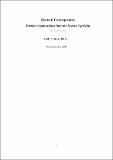Files in this item
Syria and the great powers (1946-1958): how western power politics pushed the country toward the Soviet Union
Item metadata
| dc.contributor.author | Dostal, Jörg Michael | |
| dc.date.accessioned | 2017-02-23T15:07:57Z | |
| dc.date.available | 2017-02-23T15:07:57Z | |
| dc.date.issued | 2015-11-16 | |
| dc.identifier.citation | Dostal, J. M. (2015). Syria and the great powers (1946-1958): how western power politics pushed the country toward the Soviet Union. Syria Studies, 7(4), pp. 7-52. | en_US |
| dc.identifier.uri | https://ojs.st-andrews.ac.uk/index.php/syria/article/view/1284 | en_US |
| dc.identifier.uri | https://hdl.handle.net/10023/10345 | |
| dc.description.abstract | This paper reconstructs the political history of the Syrian Arab Republic from the time of the country's emergence as an independent state in 1946 to the merger with Egypt to form the United Arab Republic in 1958. Two main sources of documentary evidence are brought to add to this analysis: firstly, declassified British government sources are utilized; secondly, the Stockholm International Peace Research Institute (SIPRI) database on arms exports to the Middle East is used to back up the descriptive analysis of Western strategic interests in the Middle East during the early Cold War period with some relevant quantitative data. From the beginning, Syria faced geopolitical challenges, which worked to undermine the country's political stability. Apart from intra-Arab conflicts and the issue of Zionist colonization in Palestine, Syria quickly developed into a focal point of the Cold War between the Western powers and the Soviet Union. This was due to the refusal of the United Kingdom (UK) and United States (US) governments to support Syria's statehood in economic and military terms. The Western rejection of substantial assistance to Syria, largely motivated by efforts to back up Israel and fully unrelated to the question of whether or not Syria was governed by democratic or authoritarian rulers, explains the country’s shift toward the Soviet Union in the mid-1950s. Next, UK and US attempts to unseat Syrian governments through covert action (especially in 1949 and 1956-1957) are examined. It is shown that these events pushed Syria’s leaders to opt for merger with Nasser's Egypt and military assistance from the Soviet Union in order to avoid further destabilization. The paper concludes that Western failure to welcome Syria as an independent actor in the Middle East, which was due to the existence of previous strategic alignment with competing states in the region, opened the door for the Soviet Union to emerge as the long-term patron of the Syrian state.International Relations | en_US |
| dc.language.iso | en | en_US |
| dc.publisher | Centre for Syrian Studies, School of International Relations, University of St Andrews | en_US |
| dc.rights | Attribution 4.0 International | * |
| dc.rights.uri | http://creativecommons.org/licenses/by/4.0/ | * |
| dc.subject | Cold War | en_US |
| dc.subject | France | en_US |
| dc.subject | Geopolitics | en_US |
| dc.subject | Middle East politics | en_US |
| dc.subject | Soviet Union | en_US |
| dc.subject | Syria | en_US |
| dc.subject | United Kingdom | en_US |
| dc.subject | United States of America | en_US |
| dc.subject.lcc | DS92.S9 | en_US |
| dc.title | Syria and the great powers (1946-1958): how western power politics pushed the country toward the Soviet Union | en_US |
| dc.type | Journal article | en_US |
| dc.description.version | https://doi.org/Publisher PDF | en_US |
| dc.publicationstatus | Published | en_US |
| dc.status | Peer reviewed | en_US |
The following licence files are associated with this item:
This item appears in the following Collection(s)
Except where otherwise noted within the work, this item's licence for re-use is described as Attribution 4.0 International
Items in the St Andrews Research Repository are protected by copyright, with all rights reserved, unless otherwise indicated.


